Please refer to Linear Programming Class 12 Mathematics Important Questions with solutions provided below. These questions and answers have been provided for Class 12 Mathematics based on the latest syllabus and examination guidelines issued by CBSE, NCERT, and KVS. Students should learn these problem solutions as it will help them to gain more marks in examinations. We have provided Important Questions for Class 12 Mathematics for all chapters in your book. These Board exam questions have been designed by expert teachers of Standard 12.
Class 12 Mathematics Important Questions Linear Programming
Question. A factory makes tennis rackets and cricket bats. A tennis racket takes 1.5 hours of machine time and 3 hours of craftsman’s time in its making while a cricket bat takes 3 hours of machine time and 1 hour of craftsman’s time. In a day, the factory has the availability of not more than 42 hours of machine time and 24 hours of craftsman’s time. If the profit on a racket and on a bat are ₹ 20 and ₹ 10 respectively, then find the number of tennis rackets and cricket bats that the factory must manufacture to earn maximum profit. Form it as an LPP and solve it graphically.
Answer. Let the factory makes ‘x’ tennis rackets and ‘y’ cricket bats.
We make the following table from the given data

Hence, the mathematical formulation of the problem is
Maximize Z = 20x + 10y
subject to the constraints
1.5x + 3y ≤ 42 ⇒ x + 2y ≤ 28, 3x + y ≤ 24; x, y ≥ 0
Convert the given inequations into equations, we have
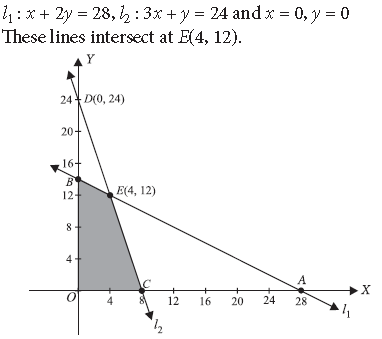
The feasible region OCEB is shown in the graph and the corner points are O(0, 0), C(8, 0), E(4, 12), B(0, 14)

Hence, the profit is maximum i.e., ₹ 200 when 4 tennis rackets and 12 cricket bats are manufactured.
Question. A diet is to contain at least 80 units of vitamin A and 100 units of minerals. Two foods F1 and F2 are available. Food F1 costs ₹ 4 per unit and F2 costs ₹ 6 per unit. One unit of food F1 contains 3 units of vitamin A and 4 units of minerals. One unit of food F2 contains 6 units of vitamin A and 3 units of minerals. Formulate this as a linear programming problem and find graphically the minimum cost for diet that consists of mixture of these foods and also meets the minimal nutritional requirements.
Answer. Let the diet contains x units of food F1 and y units of food F2. Then, the required LPP is
Minimise Z = 4x + 6y
subject to constraints
3x + 6y ≥ 80, 4x + 3y ≥ 100; x, y ≥ 0
To solve LPP graphically, we convert inequations into equations.

The shaded region CEB is the feasible region and is unbounded. The corner points of the feasible region

Therefore, the minimum cost for diet that meets the minimal nutritional requirements is ₹ 104.
Question. A dealer in rural area wishes to purchase a number of sewing machines. He has only ₹ 5760 to invest and has space for at most 20 items for storage. An electronic sewing machine costs him ₹ 360 and a manually operated sewing machine ₹ 240. He can sell an electronic sewing machine at a profit of ₹ 22 and a manually operated sewing machine at a profit of ₹ 18. Assuming that he can sell all the items that he can buy, how should he invest his money in order to maximise his profit? Make it as an LPP and solve graphically.
Answer. Let x be the number of electronic sewing machines and y be the number of manually operated sewing machines, the dealer sells. The given problem can be formulated as
Maximise Z = 22x + 18y
Subject to constraints
x + y ≤ 20, 360x + 240y ≤ 5760 ⇒ 3x + 2y ≤ 48 and
x, y ≥ 0
To solve LPP graphically, we convert the inequations into equations i.e., x + y = 20, 3x + 2y = 48, x = y = 0

The shaded region APDO is the feasible region.
The corner points of the feasible region are A(16, 0),P(8, 12), D(0, 20) and O(0, 0).

We see that the point P(8, 12) is giving the maximum value of Z.
Hence, the dealer should purchase 8 electronic sewing machines and 12 manually operated sewing machines to obtain the maximum profit under the given conditions.
Question. A manufacturing company makes two types of teaching aids A and B of Mathematics for class XII. Each type of A requires 9 labour hours of fabricating and 1 labour hour for finishing. Each type of B requires 12 labour hours for fabricating and 3 labour hours for finishing. For fabricating and finishing, the maximum labour hours available per week are 180 and 30 respectively. The company makes a profit of ₹ 80 on each piece of type A and ₹ 120 on each piece of type B. How many pieces of type A and type B should be manufactured per week to get a maximum profit? Make it as an LPP and solve graphically. What is the maximum profit per week?
Answer. Let x and y be the number of teaching aids of type A and B respectively to be manufactured per week. Then the LPP can be stated mathematically as
Maximise Z = 80x + 120y
subject to constraints
9x + 12y ≤ 180, x + 3y ≤ 30; x ≥ 0, y ≥ 0
To solve LPP graphically, we convert inequations into equations
l1 : 9x + 12y = 180 ⇒ 3x + 4y = 60
and l2 : x + 3y = 30
Both the lines intersect at P(12, 6).

The feasible region is OAPDO.
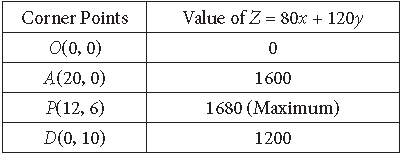
∴ The profit is maximum at P(12, 6) i.e., when the teaching aids of types A and B are 12 and 6 respectively.
Also, maximum profit = ₹ 1680 per week
Question. A cottage industry manufactures pedestal lamps and wooden shades, each requiring the use of a grinding/cutting machine and a sprayer. It takes 2 hours on grinding/cutting machine and 3 hours on the sprayer to manufacture a pedestal lamp. It takes 1 hour on the grinding/ cutting machine and 2 hours on the sprayer to manufacture a shade. On any day, the sprayer is available for at the most 20 hours and the grinding/cutting machine for at the most 12 hours. The profit from the sale of a lamp is ₹25 and that from a shade is ₹15. Assuming
Answer. Let the cottage industry manufactures x pedestal lamps and y wooden shades. Then the LPP can be stated mathematically as
Maximize Z = 25x + 15y
Subject to constraints :
2x + y ≤ 12, 3x + 2y ≤ 20, x ≥ 0, y ≥ 0.
Both the lines intersect at B(4, 4).

The corner points of feasible region are :
A(6, 0), B(4, 4), C(0, 10) & O(0, 0)

Clearly, Z is maximum at B(4, 4) So, maximum profit of `160 is obtained when 4 pedestal lamps and 4 wooden shades are manufactured
Question. Two tailors A and B earn ₹ 150 and ₹ 200 per day respectively. A can stitch 6 shirts and 4 pants per day while B can stitch 10 shirts and 4 pants per day. Form a linear programming problem to minimise the labour cost to produce at least 60 shirts and 32 pants.
Answer. Let tailor A works for x days and tailor B works for y days. Then, the required LPP is
Minimise Z = 150x + 200y
subject to the constraints
6x + 10y ≥ 60 ⇒ 3x + 5y ≥ 30,
4x + 4y ≥ 32 ⇒ x + y ≥ 8 and x, y ≥ 0
To solve LPP graphically, we convert inequations into equations.
l1 : 3x + 5y = 30, l2 : x + y = 8; x = 0, y = 0
These lines intersect at E(5, 3).
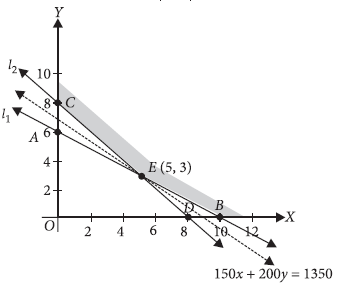
The shaded region CEB is the feasible region and is unbounded. The corner points of the feasible region are C(0, 8), E(5, 3) and B(10, 0).

From the table, we find that 1350 is the minimum value of Z at E(5, 3). Since the region is unbounded, we have to check that the inequality 150x + 200y < 1350 in open half plane has any point in common or not. Since it has no point in common.
∴ At E(5, 3), Z is minimum
Hence, tailor A works for 5 days and tailor B works for 3 days to the minimise cost.
Question. A man has ₹ 1500 for purchase of rice and wheat. A bag of rice and a bag of wheat cost ₹ 180 and ₹ 120 respectively. He has a storage capacity of 10 bags only. He earns a profit of ₹ 11 and ₹ 9 respectively per bag of rice and wheat. Formulate it as a linear programming problem and solve it graphically for maximum profit.
Answer. Let x number of bags of rice and y number of bags of wheat be purchased by the man. Then, the required LPP is
Maximise Z = 11x + 9y
subject to constraints
180x + 120y ≤ 1500 ⇒ 3x + 2y ≤ 25,
x + y ≤ 10 and x, y ≥ 0
To solve LPP graphically, we convert inequations into equations.
l1 : 3x + 2y = 25
l2 : x + y = 10 and x = 0, y = 0
These lines intersect at E(5, 5)

The shaded region OCEB is the feasible region and the corner points of the feasible region are C(0, 10),
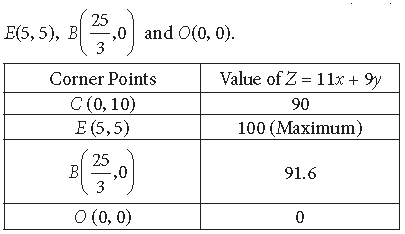
At E(5, 5), Z is maximum Therefore, a man would purchase 5 bags of rice and 5 bags of wheat to maximise the profit.
Question. A factory owner purchases two types of machines A and B for his factory. The requirements and the limitations for the machines are as follows :

He has maximum area of 9600 m2 available and 72 skilled labourers who can operate both the machines. How many machines of each type
Answer. Let x and y be the number of machines bought by the factory owner to maximise his daily output.
The mathematical formulation of the LPP is
Maximise Z = 60x + 40y
subject to the constraints
1000x + 1200y ≤ 9600 ⇒ 5x + 6y ≤ 48
12x + 8y ≤ 72 ⇒ 3x + 2y ≤ 18 and x, y ≥ 0
To solve LPP graphically, we convert inequations into equations.
l1 : 5x + 6y = 48, l1 : 3x + 2y = 19 and x = 0, y = 0
These lines intersect at E(1.5, 6.75)
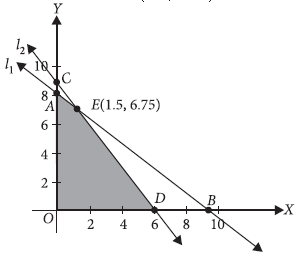
The shaded region OAED is the feasible region. The corner points of the feasible region are O(0, 0), A(0, 8), E (1.5, 6.75) and D(6, 0).
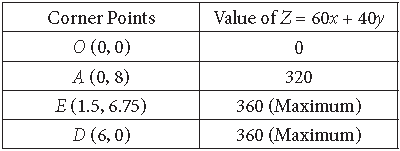
As the maximum value is obtained at D(6, 0) and E(1.5, 6.75). So, at every point of line l2, the value of Z is maximum i.e., ₹ 360
∴ By the theorem of LPP.
6 machines of type A and no machine of type B should be bought to maximise the daily output and the maximum profit is ₹ 360.
Question. There are two types of fertilisers ‘A’ and ‘B’. ‘A’ consists of 12% nitrogen and 5% phosphoric acid whereas ‘B’ consists of 4% nitrogen and 5% phosphoric acid. After testing the soil conditions, farmer finds that he needs at least 12 kg of nitrogen and 12 kg of phosphoric acid for his crops. If ‘A’ costs ₹ 10 per kg and ‘B’ costs ₹ 8 per kg, then graphically determine how much of each type of fertiliser should be used so that the nutrient requirements are met at a minimum cost.
Answer. Let the requirement of fertiliser A by the farmer be x kg and that of B be y kg.

Let Z be the total cost of the fertilisers. Then
Z = 10x + 8y
The LPP can be stated mathematically as
Minimise Z = 10x + 8y
subject to constraints 3x + y ≥ 300, x + y ≥ 240, x ≥ 0, y ≥ 0.
To solve the LPP graphically, we convert the inequations into equations to obtain the following lines:
3x + y = 300, x + y = 240, x = 0 and y = 0
Equation 3x + y = 300 meets the coordinate axes at points F(100, 0) and G(0, 300)
Equation x + y = 240 meets the coordinate axes at points C(240, 0) and D(0, 240).
The point of intersection of lines 3x + y = 300 and
x + y = 240 is E(30, 210)

The shaded region GEC represents the feasible region of given LPP and it is unbounded.

From the table, we find that 1980 is the minimum value of z at E(30, 210). Since the region is unbounded, we have check that the inequality 10x + 8y < 1980 in open half plane has any point in common or not. Since, it has no point in common. So, the minimum value of Z is obtained at E(30, 210) and the minimum value of Z is 1980.
So, the minimum requirement of fertiliser of type A will be 30 kg and that of type B will be 210 kg.
Question. A manufacturer considers that men and women workers are equally efficient and so he pays them at the same rate. He has 30 and 17 units of workers (male and female) and capital respectively; which he uses to produce two types of goods A and B. To produce one unit of A, 2 workers and 3 units of capital are required while 3 workers and 1 unit of capital is required to produce one unit of B. If A and B are priced at ₹100 and ₹120 per unit respectively, how should he use his resources to maximise the total revenue? Form the above as an LPP and solve graphically. Do you agree with this view of the manufacturer that men and women workers are equally efficient and so should be paid at the same rate?
Answer. Let x units of the goods A and y units of goods B be produced to maximise the total revenue.

The LPP is given by
Maximise Z = 100x + 120y
Subject to the constraints
2x + 3y ≤ 30, 3x + y ≤ 17, x ≥ 0, y ≥ 0
To solve LPP graphically, we convert the inequations into equations.
l1 : 2x + 3y = 30, l2 : 3x + y = 17 and x = 0, y = 0
These lines meet at P(3, 8).
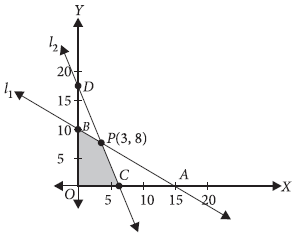
The feasible region OCPB has been shaded.
The corner points of the feasible region are O(0, 0), C(5.6, 0), P(3, 8), B(0, 10)

Clearly, the maximum revenue is obtained at P(3, 8),
i.e., when 3 units of good A and 8 units of good B are produced.
Yes, I agree with the view of the manufacturer. Men and women workers should be equally paid so that they can do their work efficiently and accurately.
Question. A dietician wishes to mix two types of foods in such a way that the vitamin contents of the mixture contains at least 8 units of vitamin A and 10 units of vitamin C. Food I contains 2 units/kg of vitamin A and 1 unit/kg of vitamin C while food II contains 1 unit/kg of vitamin A and 2 units/kg of vitamin C. It costs ₹ 5 per kg to purchase food I and ₹ 7 per kg to purchase food II. Determine the minimum cost of such a mixture. Formulate the above as an LPP and solve it graphically.
Answer. Let x kg of food I and y kg of food II be purchased, then the given data can be represented in the tabular form as follows :

∴ The given LLP is as follows.
Minimise Z = 5x + 7y
Subject to the constraints
2x + y ≥ 8, x + 2y ≥ 10, x ≥ 0, y ≥ 0
To solve LPP graphically, we convert inequations into equations.
l1 : 2x + y = 8, l2 : x + 2y = 10
These lines intersect at P(2, 4)

From the graph, the corner points of the feasible region are C(10, 0), P(2, 4) and B(0, 8).

From the table, we find that 38 is the minimum value of Z at P(2, 4). Since the region is unbounded, we have to check that the inequality 5x + 7y < 38 in open half plane has any point in common as not. Since, it has no point in common. So the minimum cost is ₹ 38 and this is attained at P(2, 4), i.e., when 2 units of food I and 4 units of food II are purchased.
Question. A diet for a sick person must contain at least 4,000 units of vitamins, 50 units of minerals and 1400 calories. Two foods A and B are available at a cost of ₹ 5 and ₹ 4 per unit respectively. One unit of the food A contains 200 units of vitamins, 1 unit of minerals and 40 calories, whereas one unit of food B contains 100 units of vitamins, 2 units of minerals and 40 calories. Find what combination of A and B should be used to have least cost satisfying the requirements.
Answer. Let x units of food A and y units of food B be used. The data of the given problem is

Then, mathematical formulation of the LPP is
Minimize Z = 5x + 4y
subject to constraints
200x + 100y ≥ 4000 ⇒ 2x + y ≥ 40,
x + 2y ≥ 50,
40x + 40y ≥ 1400 ⇒ x + y ≥ 35 and x, y ≥ 0
To solve LPP graphically, we convert inequations into equations.

The shaded region AGHD is the feasible region and is unbounded. e corner points of the feasible region are A (0, 40), G(5, 30), H(20, 15), D(50, 0).
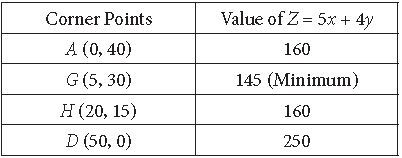
From the table, we find that 145 is the minimum value of Z at G (5, 30). Since the region is unbounded we have to check that the inequality 5x + 4y < 145 in open half plane has any point in common or not.
Since it has no point in common.
∴ At G(5, 30), Z is minimum.
Hence, least cost is ₹ 145 when 5 units of food A and 30 units of food B are used.

